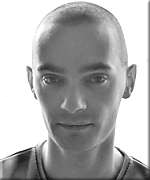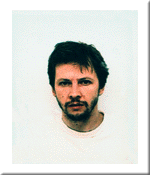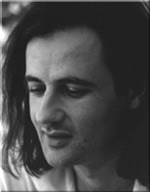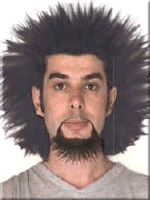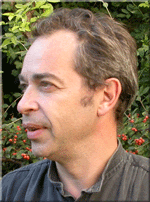|
|
|||||||||||
|
P A R I S
C O N N E C T I O N |
1. A Group of Differences “Something beautiful is unfolding in Paris”—Jim Andrews’s line about the six French artists of Paris Connection is clearly enthusiastic. Why should it not be, considering this group of artists, who are familiar with each other, collaborate with each other, and work with the same software? It almost looks like a local movement in the new field of digital art. Is it? What would the manifesto of this movement be? It is not easy to answer this question. As Helen Thorington notes, each of these artists is unique but there are connections between them. And indeed, they are different in terms of screen design, interaction, and philosophy. There is the minimalist techno aesthetic of servovalve, whose “ligne de ville” can be seen as a “cosmic piece”, the “architecture of the heavens”, as Andrews states, or as the symbol of the Web itself creating lines between nodes within a second always changing perspective, continually presenting new areas of this virtual realm. The ironic aspect is that often the lines are drawn even before the nodes exist like in an autopoetic system. I am sure this piece (or the equally minimalist and equally hypnotic “x-liner”) would do very well as ambient art in a club. Antoine Schmitt’s “avec determination” shares the techno design with servovalve but invovles a different concept. Here one is required to participate in the artificial entities’ struggle to leave the box, only to realize one’s own helplessness. In contrast to Schmitt’s pieces, the work of Nicolas Clauss is impressionistic in design and much more ‘user friendly’ concerning interaction. Clauss invites the user to choreograph the dance of his Flying Puppets appearing on the screen to the cheerful violin music by Thomas Le Saulnier. In comparison with Servovalve and Schmitt these dance pieces are buoyant and optimistic. In a similar way, Jean Luc Lamarque allows the user to be creative in his piece “Pianographique”, which is an interactive visual-music instrument played with the keyboard. Lamarque's piece, as well as Clauss’s “Simple Paint” or “Typed Paint,” stress the user’s involvement in art, and could also be considered tools to produce pieces of art. Such a tool is to be found in Durieu’s “Puppet Tool” as well, where users can manipulate the virtual body of animals and create grotesque bodies. Since the results can be sent to the website and saved to be displayed to other users, interaction leaves the closed relation between user and their screen and is looped back to the web community. Jean-Jacques Birgé is the only one who does not work with Director. He is a movie director, musician and sound designer, who not only practices but also teaches and writes about multimedia. Therefore (and probably due to his age and experience as well) he is a central figure in this group. As Andrews notes, they all speak of him, they all listen to him. Birgé has introduced some of them to one another, he hosts their meetings, and he co-authors and composes the music for pieces of Schmitt, Durieu, Lamarque, and Clauss. 2. Digital Art and Experiments While a closer look reveals how the art of these six Frenchmen differ in many ways, there is one thing (besides the locality and the program) all of them have in common: the collaborative synthesis of arts, media, mathematics and programming. Does this establish a new movement in art? No, it establishes a new kind of art. One may call it webart for it can be found on the web. More precisely one may call it digital art as long as it uses the web only for presentation and can equally exist on other digital media as floppy disk or CD-ROM. Much more important than the place of presentation is the aesthetic advantage this art takes of the features of digital media. In the work under discussion such advantage lies in programming rather than in the connectiveness the web provides. With the exception of Durieu’s “Puppet Tool” all pieces are stand-alone pieces, copied to the user’s computer without any way to be brought back into the communication on the web. The interaction the user performs with these pieces remains invisible to the world. But whatever one calls it, what is important is that there are such brilliant webartists/digital artists on the planet. Could the same be said about writers of digital literature? What could be equivalent pieces in digital literature, equally fascinating and convincing in the way they deal with their material? Michale Joyce’s canonized hyperfiction “Afternoon. A Story”, Caitlin Fisher’s awarded “These Waves of Girls” [1], or “Filmtext 2.0” [2] by the highly praised Mark Amerika? Or would it rather be a “soft poetry” piece like “A Fine View” by David Knobel, a text-movie such as Young-Hae Chang’s “Dakota”, or an audio-visual rollover-poem like “Yatoo” [3] by Ursula Hentschläger and Zelko Wiener from Austria? This is certainly not the place to comment on those pieces in particular. Lets just admit that neither German nor English digital literature has become as popular as digital art just yet. Why is that? Two answers come to mind: different expectations of the audience and different purposes of the authors. Although some of the introduced French artists downplay their relationship to programming in the interviews with Andrews (Clauss is “not interested in code,” Servovalve is “not really a programmer”), they are not scared of learning programming at all. Their code work is impressive and seems to meet the demands of doing something new, something amazing/ interesting within the new medium. It is the connection of these skills with artistic aspirations that is important. Certainly, not everyone who studied painting will, as Clauss does, “use the internet as a canvas,” as he says in the Andrews interview. One needs a certain attitude, one needs the desire to experiment, and one must possess excitement to look for new material. The artists under discussion share such attitudes and desires. Clauss, for example, whose aspiration is “to experiment with the space between video, interactivity and painting,” had already used (as a ‘conventional’ painter) found objects in the tradition of Duchamp. Servovalve united the visual discipline with music, which finally brought him to programming. Lamarque learnt programming in order to combine his musical interests with being a painter. They are all open to hybrid, cross media art; digital media is the natural home for their experiments. And though there are a lot of traditional painters to be found, such openness is typical of artists in the field of fine art. They are much more inclined than writers to reflect on their material and to look for new ways to work with it or for new material. Well, it certainly would be incorrect to say writers do not reflect on their material. But they generally think of the subject matter as the 'material,' and don't pay much attention to the materiality of language itself. Literary experiments focus on language rather than the way language is presented on the graph(em)ic level. Take Borges's labyrinths in contrast to hypertexts, for example: while the former creates labyrinthine narrations, which nevertheless have to be read from the top left to bottom right, hypertext intends to materialize the labyrinth on the page itself. In experimental hypertexts, the material to experiment with starts before the language, one could also say it is “outside the head”. The new way of writing is to be seen, comparable to concrete poetry, which equally draws attention to the visual aspect of language. While hypertext and concrete poetry are examples of literary experiments on the visual level of words (and hence constitute a twilight zone phenomenon belonging to both literature and fine arts) experiments in literature mostly happen on the level of pure language. The results are such avant garde writings as Lawrence Sterne's digressive and meta-reflexive storytelling, Nouveau Roman, Borges’s and Calvino’s text labyrinths, or Robert Coover’s multi-ending though linear story “The Babysitter”. And while visual art continues to experiment with its material (take Young Hay who carries a white canvas through the world as if to bring Malevich’s white square into a new context), literature seems to have arrived at a point where experiments are banned in favor of traditional storytelling. This impression derives from the debate about current German literature in the 90’s, in which almost only professors of aesthetics did not require lively, accessible, entertaining narratives instead of self reflexive, eventless, opaque, well, lets just say “decadent” texts. What shall one expect from literary experiments within digital media if people want to read novels starting with a sentence like “The Marquise went out at five.“ The problem seems to lie in the art form. Visual art demolished realistic rendition a long time ago. The audience has adjusted and is nowadays eagerly visiting the big abstract painting exhibitions. The audience has learned that painting can involve sensual stimulation rather than mimicry or realism; the new effects of digital technology seem to fit perfectly into such agendas. In literature, on the other hand, sensual stimulation will not satisfy if it fails to meet the demands of meaning-centered expectations. As much as Nouveau Roman always remained a speciality of a small circle of writers and readers, hyperfictions or dynamic texts [4] hardly ever will gain popularity. Considering these different expectations and reactions, it should be no surprise that digital experiments with visual art are much more developed and viewed by a wider audience than digital experiments with literature. This will not be helped by a new concept : "algorithmic poetry," Birgé's description of the work in "Alphabet". Durieu says, of his work in general: “the aim of all this is to create poetry. So, I like to speak about algorithmic poetry. A poem is a text that procures you poetry if you read it. The code I'm trying to write is a text that procures you poetry if a computer reads it for you...." One may call it poetry – as much as one may speak of a perfect meal as a poem. When it comes onto the screen Durieu’s code is rendered into sound, images and a paradigm of interaction like in he and Birgé's “Week End”, where you see many clouds and hear a lot of car crashes but not a single word. 3. Designs and Meaning It would be worth discussing whether, in the field of literature, meaning-centered expectations embody a conventional aesthetic whereas writings focusing on the material of language (as mannerism, l’art pour l’art, or language poetry) represent a more experimental, more avant garde aesthetic. Part of this discussion should be whether, in visual arts, modes of spectator experience based on intensities of direct sensual stimulation (rather than symbolic concerns) stand for an advanced aesthetic or, instead, are involved in the shift towards aesthetics of surface spectacles that Andrew Darley describes in his book “Visual Digital Culture”. Leaving this discussion for another place and time, I just want to ponder whether our six artists support such a shift towards an aesthetic of surface spectacle. According to Lev Manovich’s essay “Generation Flash” (which focuses on “Flash aesthetics” rather than the program “Flash”) a result of digital media is that the software-artist outdates the media-artist, who, in the 60’s outdated the romantic artist. While the media-artist uses media technologies as tools as well as the content of commercial media as its own content (the re-photographed photograph of a newspaper or the isolated segment from a TV show recontextualized in a media-installation) according to Manovich the software-artist creates from scratch, like the romantic artist once did. Of course, software-artists produce as little from scratch as romantic-artists did (being the result of all the discourses in which they have participated). If the media-artist is “a parasite who lives at the expense of the commercial media,” the software-artist lives at the expense of those whose software or programming language they are using in coding their own ‘original’ work. The software-artist is part of a “vertical collaborative authorship” because almost every developer of a program or application is a user of software one level removed. I will discuss this aspect later with respect to Nicolas Clauss’s paint-program as tool or artefact (see review on Clauss). Important for now is Manovich’s statement about the software-artist’s intention: “This generation does not care if their work is called art or design. This generation is no longer interested in ‘media critique’, which preoccupied media artists of the last two decades; instead it is engaged in software critique….In contrast to visual and media artists of the 1960s-1980s, whose main target was media—ads, cinema, television—the new generation does not waste its energy on media critique. Instead of bashing commercial media environments, it creates its own: Web sites, mixes, software tools, furniture, cloves [sic], digital video, Flash / Shockwave animations and interactives.” No media critique anymore? No critique at all? Design instead of art? The websites Manovich cites as examples seems to illustrate that software-art is just about showing the ‘technical muscles.’ Now, the gesture of clicking and moving, inherent to digital media seems to support the rhetoric of surface spectacle and the aesthetics of the sensual. Within these media, Beuys's statement that everybody has the potential to be an artist causes rather mixed feelings if it is based on sophisticated programming: geeks as artists, like the brilliant programmer and hopeless would-be-writer Adolph Knipe in Roald Dahl’s “The Great Automatic Grammatizator”? The final victory of the engineer over the artist! Fortunately, things are not that easy. As mentioned above, our six Frenchmen have a history prior to the Web. They mostly have been artists before becoming programmers, which sets a different accent and gives hope they do not simply surrender to technical effects. This is not to say they would or should avoid such effects. However, if we just take some of the titles they give their work as inscriptio we know the intention goes far beyond programming: “Week End” by Birgé and Durieu boldly refers to Godard and “Mechanical Brushes” by Clauss, with the ‘subscriptio’ “A moving still life with used brushes (a provisory goodbye to painting)”, raises the issue of painting as such. One should be ready for two things, and not just concerning the work presented in Paris Connection:
There are more aspects to be discussed regarding digital art; authorship and innovation are two of them. Some pieces (like “Pianographique” by Lamarque and “Simple Paint” by Clauss as well as “Nio” by Jim Andrews) are tools and works of art. Who is to be considered the author of what results out of using these tools: the user, the creator of the tools, or the creator of the software the tools are programmed with? Although some of our artists do not consider themselves programmers, their programming is quite sophisticated, and this is often a precondition for the creation of impressive work. This should not surprise us since digital art by definition is based on digital code. Does this mean that those who are experimenting with digital media but are not out for the code eventually fade? With respect to digital media, does the imperative of art to keep on learning mean to keep on learning code? Paris Connection certainly cannot answer all these questions. However, it introduces some of the most interesting ‘software-artists’ and gives useful background information to their work and aesthetics. NOTES:
|
||||||||||
|
|||||||||||

